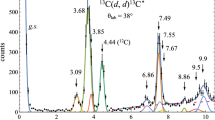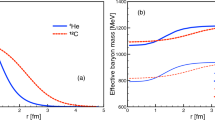Abstract
A study of nuclear reactions leading to the formation of π-mesons is of value for understanding nuclear forces. A radiochemical method is used for detecting such reactions and this makes it possible to determine the cross section of reactions of very low probability.
Reactions of the type (p,π=) and (p,pπ) have been studied with the nuclei of elements of average atomic weight. It was found that their cross section equals ∼ 10−30 cm2/nucl. at proton energies of 480–660 Mev. A noticeable increase in the cross section was observed in the range of energies 110–480 Mev. Such reactions could not be detected for nuclei of heavy elements. The products of the (p,¦2π+) reaction with copper could hot be identified.
The possibility of a (p.π=) reaction in the interaction of a particle with a complex of nucleons in a nucleus is discussed. The information obtained gives a fuller understanding of the processes occurring when high-energy particles react with complex nuclei than can be obtained from the theory of nucleon-nucleon collisions.
Similar content being viewed by others
Literature
Si.C. Fung and A. Turkevich, Phys. Rev.,95, 176 (1954).
S. Sekerskii and A. K. Lavrukhina, Doklady Akad. Nauk SSSR117, 61 (1957).
A. P. Vinogradov, I. P. Alimarin, V. I. Baranov, A.K. Lavrukhina, T.V. Baranova, F.I. Pavlotskaya, A.A. Bragina, and Yu. V. Yakovlev, Session of Acad. Sci. USSR on Peaceful Uses of Atomic Energy, June 1–5, 1955 (Meeting of the Div. Chem. Sci.) [in Russian]. (Moscow: Acad. Sci. USSR Press, 1955) p. 97.
G. Seaborg, I. Perlman, and D. Hollander, Table of Isotopes [Russian translation]. (Moscow: Foreign Lit. Press, 1956) pp. 57, 58.
J. Miller and G. Friedlander, Bull. Am. Phys. Soc.28, 3, UA4 (1953).
A. P. Vinogradov, I. P. Alimarin, V. I. Baranov, A.K. Lavrukhina, T.V. Baranova, and F.I. Pavlotskaya, Session of Acad. Sci., USSR on Peaceful Uses of Atomic Energy, July 1–5, 1955 (Meeting of Div. Chem. Sci.) [in Russian]. (Moscow: Acad. Sci. USSR Press, 1955) p. 132.
A.K. Lavrukhina, Doctor's Dissertation [in Russian]. (Moscow: GEOKhl Acad. Sci. USSR, 1955).
G. Germain, Phys. Rev.82, 526 (1951).
Annual Rev. Nuclear Sci. 1, 1 (1952).
B. S. Neganov and O. V. Savchenko, J. Exptl.-Theoret. Phys. (USSR)32, 1265 (1957).
V. I. Veksler, Doklady Akad. Nauk SSSR 82, 865 (1952).
L.S. Azhgirei, I.K. Vzorov, V. P. Zrelov, M. G. Meshcheryakov, B.S. Neganov, and A. F. Shabudin, J. Exptl.-Theoret. Phys. (USSR)33, 1185 (1957).
O.V. Lozhkin, J. Exptl.-Theoret. Phys. (USSR) 33, 354 (1957).
N. T. Porile and N. Sugarman, Phys. Rev.107, 1422 (1957).
V.B. Kurchatov, V.N. Mechedov, L.V. Chistyakov, M. Ya. Kuznetsova, N. I. Berisova, and V. G. Solov'ev, J. Exptl.-Theoret. Phys. (USSR)35, 56 (1958).
D. I. Blokhintsev, Uspekhi Fiz. Nauk61, 137 (1957).
Rights and permissions
About this article
Cite this article
Lavrukhina, A.K., Grechishcheva, I.M. & Khotin, B.A. Radiochemical studies of nuclear reactions leading to the formation of π mesons. The Soviet Journal of Atomic Energy 6, 79–82 (1960). https://doi.org/10.1007/BF01836105
Received:
Issue Date:
DOI: https://doi.org/10.1007/BF01836105




